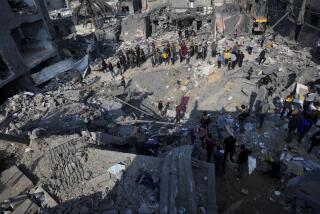Smoking Gun
- Share via
On a wintry morning in January 1942, 15 German bureaucrats, representatives of ministries responsible for the “Jewish question,” repaired to a comfortable villa by a lake in Wannsee, a suburb southwest of Berlin where members of the German bourgeoisie had been summering since the late 19th century. The villa had a lake view, a music room and a billiards table and offered pleasant food, central heating and hot and cold running water. The men sat around a table for perhaps an hour and a half. They talked; they listened; they conferred. By the meeting’s end, fortified by brandy, they appear to have sealed the fate of European Jewry.
This meeting, which was known as the Wannsee Conference, produced a document, “The Wannsee Protocol,” which was discovered in 1947 and called “perhaps the most shameful document in modern history” by Robert Kempner, the man responsible for prosecuting the German ministries after the war. Shameful it was, indisputably, yet for more than half a century both the protocol and the conference have retained a mystery as to their exact place, and purpose, in the Nazis’ murderous campaign against the Jews.
In “The Wannsee Conference and the Final Solution,” Mark Roseman sets out not to solve this mystery so much as to anatomize it, to dissect the thinking of the key players and to present the central themes, ideas and intentions of the day. He does so with the same determination and respect that he brought to “A Past in Hiding,” his life of Marianne Strauss, an “ordinary” young German Jewish woman who lived in open hiding in wartime Nazi Germany, which remains an unforgettable contribution to Holocaust studies.
“The Wannsee Conference” is a narrower, and less narrative, book. Roseman’s subject is not, this time, the victims but the perpetrators of the Nazi genocide, and his focus is even tighter as he seeks to interpret what he calls “the Rosetta stone of Nazi murder,” a “deeply mysterious document [that] seems to capture the precise moment when the Nazis decided to eliminate the Jews.”
Why so much seeming and appearing, why so much mystery and perhaps? First, the central facts: The meeting was called by Reinhard Heydrich, head of the Nazi Security Service and chief of the German Security Police. Accompanying him were his Gestapo chief, Heinrich Muller, and his subordinate, Adolf Eichmann. In addition to the ministries’ representatives (Interior, Justice, Economics, Propaganda, Foreign Office, Occupied Eastern Territories and so on), the other invitees were all from party and SS agencies with a special interest in race questions. They were mostly young, well-educated and politically ambitious.
The protocol is not the actual transcript of the minutes but the version that Heydrich edited and later distributed to the participants (the copy that survives is No. 16 of 30). As thus represented, the meeting, which Heydrich led, began with his survey of the measures taken by the Nazis toward the Jews up to 1941. These included the removal of the Jews first from “every sphere of life of the German people”; expulsion of the Jews from the “living space” of the German people; emigration; and “a new solution,” evacuating Jews to the East. These steps are seen as providing only temporary relief, which is nonetheless “of great significance for the coming final solution of the Jewish question.”
Next there is a tally, country by country, including those under German control and those not, of the more than 11 million European Jews who would be affected by this “coming final solution.” After that the protocol moves on to detail this “solution,” the evacuation of Jews in the East, where “doubtless the large majority will be eliminated by natural causes.” The human beings who survive, “the most resistant elements,” “will have to be dealt with appropriately.” From here the meeting took up issues concerning half- and quarter-Jews, war-decorated Jews and mixed Jewish and gentile marriages.
“Despite using the language of evacuation,” Roseman observes in declarative passage early on his book, “the minutes unmistakably contain a plan for genocide, formulated in sober bureaucratic language, deliberated on in civilized surroundings in a once cosmopolitan suburb of Berlin.”
If the plan for genocide is unmistakable, what, then, is so confounding about the protocol? For one thing, there is the bedeviling issue of chronology. The protocol implies that the groundwork for the Final Solution had still not been prepared in January 1942 and therefore poses a question central to the history of the Holocaust: Was genocide the result of a long-established plan or was it worked out as the war unfolded?
Could the Wannsee Conference be the moment, and the place, at which the Nazis decided to exterminate the Jews? Roseman, after some consideration, believes not, for several reasons: Hitler was not at the conference; the attendees were too junior to make such a decision on their own; and the timing seems off, since the mass murder of Soviet Jews had begun six months earlier, Polish Jews had been gassed at Chelmno since early December 1941 and the death camp at Belzec was already under construction.
For Roseman, all this makes the protocol at once perplexing and compelling; he sees it as a rare “keyhole through which we can glimpse the emerging Final Solution,” but he also recognizes that it is a document, “not a camera-eye view.” And although the document is lean, chilling and bureaucratic, a curious mixture of “procedure and prejudice,” it leaves a number of questions unanswered. It does not specify the means of killing; it doesn’t say who decided what and when; and it does not--even--precisely confer guilt.
At his trial in Jerusalem, Eichmann insisted that the language at the actual meeting had been more open about the killings than the protocol suggests; but this was in keeping with his defense, that his superiors had given clear killing orders. At the Nuremberg trials the ministerial bureaucrats contradicted Eichmann, maintaining that nothing had been said openly; even Friedrich-Wilhelm Kritzinger (from the Reich Chancellery), who was alone among those examined by Kempner after the war in expressing his shame, denied that the killings had been discussed.
Where does all this leave us? Roseman believes that “The Wannsee Protocol” captures the moment when a comprehensive plan for the annihilation of the Jews was just emerging. Like the inconsistent fossil record that anthropologists work with in establishing the evolution of early man, the protocol emerges as just one particularly ugly, unusually--if still elusively--specific piece of evidence to have survived from the Nazi regime. Historians may circle around the decisions it pinpoints, or fails to, but this much at least remains clear: The Nazis, primed by Hitler to destroy the Jews, had no compunction about advancing their campaign through killing, and what Roseman calls the “most shameful document” demonstrates that the “deed of murder begat the idea of genocide as much as the other way around.”
More to Read
Sign up for Essential California
The most important California stories and recommendations in your inbox every morning.
You may occasionally receive promotional content from the Los Angeles Times.













